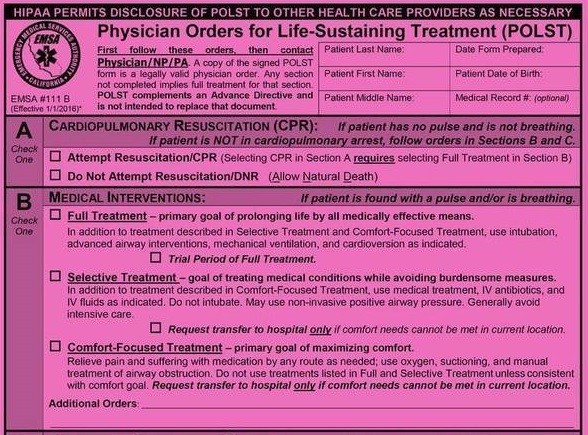Providers should be aware of and be involved in the conversation about these upcoming registries as they will interact with them frequently.

By Jaskaran Singh, MD, Amelia Breyre, MD
You arrive on scene to a call of a 72-year-old woman with metastatic lung cancer who has difficulty breathing at her nursing facility. The woman is unresponsive and thready pulses become difficult to palpate. The nursing facility staff is unable to locate any paper POLST forms. What are your next steps?
The POLST program – Physician Orders for Life-Sustaining treatment – was developed by medical ethicists in Oregon in 1991 as a tool to help honor patients’ wishes for end-of-life treatment.1 Today, all 50 states and Washington, DC, have existing POLST programs with varying functional capacities and names for the actual form (i.e. Medical Order for Life Sustaining Treatment (MOLST), Physician Order for Scope of Treatment (POST) etc.). POLST forms are most useful for people who are medically frail or seriously ill from chronic, progressive health conditions. They contain important, actionable medical orders that are portable for use across health settings – such as emergency medical services (EMS), emergency departments and long-term care facilities.
Several studies have demonstrated the efficacy of POLST forms over the years. POLST forms have been shown to have significant advantages over traditional methods to communicate preferences regarding life-sustaining treatments,2 and their use has been shown to result in a very high percentage of patients receiving care consistent with their prior expressed wishes.3 However, their use is not without barriers. One key barrier can be their inaccessibility. The form, if not readily available to health care providers, isn’t helpful in time-critical situations. A 2004 survey of Oregon EMTs showed a quarter of respondents stated that they were unable to successfully find a POLST in a timely manner the last time they had expected to do so.4 In 2009, Oregon legislation introduced an electronic POLST registry. This was to address EMS challenges in accessing or locating original POLST orders when they arrived on the scene of a medical emergency. By 2015-2016, nearly half of all deaths in Oregon had an active form in their electronic registry.5 As of 2020, the Oregon Registry has almost half a million POLST forms.6
California’s Assembly Bill No. 1234 was introduced by Assembly Member Arambula (D-Fresno) in February 2021 and would require the California Health and Human Services Agency to establish a statewide electronic POLST registry system.7 It is being backed by the Coalition for Compassionate Care of California (CCCC) and Arambula, himself, is a prior emergency physician. In addition to creation of a statewide registry, the bill lays out a timeline for its implementation (2024-2026), ensures that an electronic POLST (ePOLST) would have the same legal standing as a paper form, and that electronic signatures could be used.
As of 2020, at least 10 states have started development of or already created statewide registries.8 Some registries have capability for electronic form completion, some function simply as databases, and others have a hybrid system. Input from pilot studies that have been performed in San Diego and Contra Costa County along with experiences with ePOLST registries from other states are helping shape what California’s statewide registry will eventually look like.

ePOLST registries have several advantages over the traditional POLST. The main advantage being their universal accessibility by healthcare providers and patients. Other potential advantages include the ability to provide educational material to patients at time of form completion, development of mechanisms to prevent incomplete or incongruent (i.e. Full Code + Do Not Intubate) form submissions,9 and remote signing. However, there are several potential pitfalls to be mindful of – such as assuring the repositories are HIPPA-compliant, easily searchable, interface with local health information exchanges, and have back-up mechanisms for access (i.e. call center) in case of technology failure.
EMS will be at the forefront of interfacing with these registries and as such should be involved in the conversation regarding their development. Properly developed and implemented, a state-wide ePOLST has the opportunity to improve EMS and emergency departments provider POLST access difficulties, facilitate accurate POLST completion, and improve our ability to provide patient’s with the care they want near the end-of-life.
References
- National POLST: History [Internet]. Washington DC: National POLST; c2017-2021. [cited 2021, Nov 3]. Available from: https://polst.org/history/
- Hickman SE, Nelson CA, Perrin NA, Moss AH, Hammes BJ, Tolle SW. A comparison of methods to communicate treatment preferences in nursing facilities: traditional practices versus the physician orders for life-sustaining treatment program. J Am Geriatr Soc. 2010 Jul;58(7):1241-8. doi: 10.1111/j.1532-5415.2010.02955.x. PMID: 20649687; PMCID: PMC2963454.
- Hopping-Winn J, Mullin J, March L, Caughey M, Stern M, Jarvie J. The Progression of End-of-Life Wishes and Concordance with End-of-Life Care. J Palliat Med. 2018 Apr;21(4):541-545. doi: 10.1089/jpm.2017.0317. Epub 2018 Jan 3. PMID: 29298109.
- Zive DM, Schmidt TA. Pathways to POLST registry development: Lessons learned. Portland, OR: Center for Ethics in Health Care Oregon Health & Science University. 2012.
- Dotson A, Broderick A, Steinmetz V, Weir J, Anthony S. (2019) California’s POLST electronic registry pilot: Lessons for all states. Oakland, CA: California Health Care Foundation. Available from: https://www.chcf.org/wp-content/uploads/2019/09/CaliforniasPOLSTElectronicRegistryPilot.pdf
- Dotson, A. (2020). Oregon POLST registry annual report. Portland, Oregon: Oregon POLST Registry. Available from: https://orpolstregistry.files.wordpress.com/2021/03/2020-oregon-polst-registry-annual-report.pdf
- Physician Orders for Life Sustaining Treatment forms: registry, Cal. Assemb. B. 1234 (2021-2022)
- National POLST: Registry Information [Internet]. Washington DC: National POLST; c2017-2021. [cited 2021, Nov 3]. Available from: https://polst.org/wp-content/uploads/2021/03/2021.03-National-POLST-Registries-Matrix.pdf
- POLST California: POLST eRegistry in California: Challenges and opportunities [Internet]. Sacramento: Coalition for compassionate care of California; c2021. [cited 2021, Nov 3]. Available from: https://capolst.org/wp-content/uploads/2020/11/POLST-INTERVIEW-REPORT_11-22-19.pdf
Complete Article ↪HERE↩!
